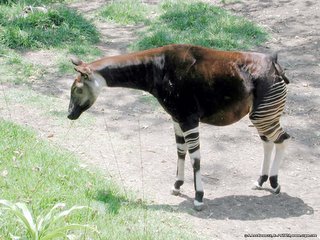"It fuses three Greek words: kryptos, zoon, and logos, which mean, respectively, hidden, animal, and discourse. Thus cryptozoology is the science of ‘hidden animals.’ Heuvelmans (ed note: historically known as the father of cryptozoology) prefers ‘hidden’ to ‘unknown’ because to those people who live near them, the animals are not unfamiliar; if they were, there would be no native accounts, and we would never have heard of them. They are, however, undetected by those who would formally recognize their existence and catalogue them."I was exposed to cryptozoology only just a few years ago, while doing research for a book Rich and I were writing at the time. Across many different texts I began compiling quite a lengthy list of creatures/animals that had been characterized by science as "fabulous animals", which was academic code for make-believe. But what caught my attention... was that several of these creatures were referenced in the Bible. Well, that’s fine if you believe that the Bible is just a collection of made-up stories anyway. Of course there should be fictional animals found within as well. But this is not the view I held (or hold now for that matter). So, I decided to investigate the issue further. Perhaps, I thought, the scripture references were used in a symbolic context. However, that’s when things got real sticky for me.
It seemed that many of the instances where the "fabulous animals" were mentioned in the Bible, the writer used these animals in similes, as an example, or to clarify a more complicated point. For instance in Numbers 23:22 where a unicorn's strength is compared to Egypt’s. As a writer, it was somewhat difficult for me to fathom another writer trying to make his point or explain himself in layman’s terms by comparing something real to something fictional when there were so many other real-life examples available to him.

It was also intriguing to find that newer versions of the Bible had apparently re-translated these particular verses in light of the prevailing scientific thought of their time. And had replaced the fabulous animals' names with other known animals whose descriptions didn’t always match that of the original animal or sometimes even what seemed to be the author’s point of emphasis.
This trend was particularly disturbing to me as I learned that many animals which I have seen in zoos with my own eyes have only been acknowledged by science in the last hundred years or so. Animals like the okapi pictured here(which is my new favorite animal ever since I was mesmerized by one at the San Diego Wild Animal Park) "discovered" in 1901, the Komodo dragon-1912, and the giant panda, which was somewhat acknowledged in 1869 but not captured until 1936. These animals though elusive or rare, obviously exist. What if some of the other "fabulous animals" do as well?
Skeptics are quick to trot out the much-publicized Bigfoot and Loch Ness monster and their associated hoaxes as evidence of the silliness or chicanery of cryptozoology, but even my limited research has revealed a much wider breadth of study than this and a logical approach from cryptozoologists.
In addition to the Hmmmm Links on the sidebar, you might also be interested in these other websites related to this topic. I’ve found them to be thought provoking. They are:
Philip Burn's Cryptozoology Links, which contains an exhaustive list
The Medieval Bestiary
The Catholic Encyclopedia: Animals in the Bible
Cryptozoology

No comments:
Post a Comment